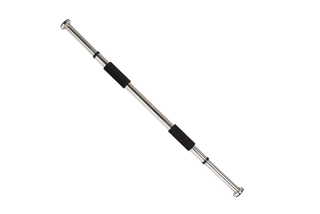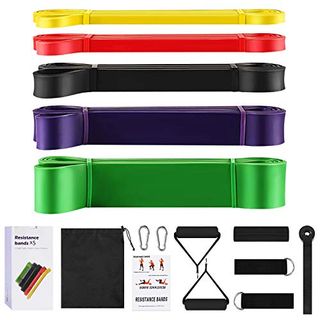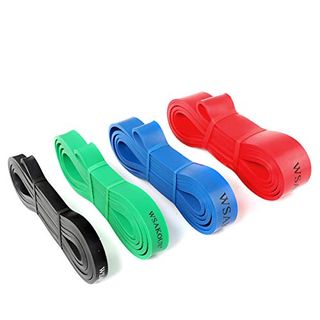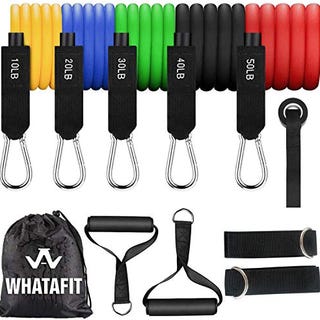The idea of doing pull-ups makes most cyclists shiver. But having the strong upper body and core required to do a single pull-up can also provide you with more power and stability on the bike and decrease your injury risk.
That’s why I decided to find out what happens when a cyclist works on pull-ups every day for a month.
A small confession: I can do pull-ups, and always have been able to. Even in my least athletic days, back when I would feign a faint or vomiting episode (true story) to get out of running the mile during the Presidential Physical Fitness Test in middle school (remember those?), I could pull off a pull-up or two.
But my practice with pull-ups is spotty at best, despite knowing that I tend to feel my best when my body’s strength feels more balanced. My current strength level is also at a serious low, and purposefully so. I recently did a 100-mile trail run (gross, I know) and to prep for that, I stopped my strength routine way back in August in order to focus on high-mileage running, with only cycling for cross-training.
My goals are now less about ultra-endurance and more on building strength back. In this case, my pull-up goal may look different than that of other cyclists. I’m not aiming to be able to pull off a single pull-up in 30 days; I’m trying to increase my pull-ups from banging out a couple of reps with just-okay form to being able to do a solid set of 10. (That’s not to say that a single pull-up isn’t a worthy goal, because it very much is!)
How it started…
This content is imported from YouTube. You may be able to find the same content in another format, or you may be able to find more information, at their web site.
Above, my pull-up starting point and below, all you need to know about the pull-up, plus how my experiment went.
Why should cyclists do pull-ups anyway?
“When you’re riding, especially off-road in mountain biking or cyclocross, you’re using your arms as your suspension, so being able to move your body with your arms is incredibly helpful,” says cyclocross and track pro Ruby West of Jukebox Cycling. “I notice most when I’m not able to do this, and I’ll finish a race with incredibly sore arms, or find myself feeling weak in the arms and shoulders. And that’s generally a good sign that I should hit the gym again sometime soon.”
Pull-ups tend to be a good indicator of overall fitness and health, since they’re not just about biceps or back muscles. A good pull-up requires a strong core and enough strength to lift your full body weight.
“I feel like I notice a big difference in my strength on the bike when I am able to do pull-ups,” West says. “I’d say they are a good benchmark to what I like to call the ‘noodle-ness’ of my upper body, which is highly measurable by how many pull-ups I can do at any point. I think it’s a great way to test your strength because it is body weight and something replicable wherever you are.”
Pull-ups are also part of the strength routine for pro gravel racer and track cycling world champion Ashton Lambie. Not only did he do pull-ups to have an upper body that could help make track starts faster, he says that pull-ups help develop that stable core necessary for maintaining power over hundreds of bumpy gravel miles.
Plus, the stronger your core, the less pressure there is on your hands, which can help if you’re someone who regularly deals with hand numbness on the bike.
“For off-road disciplines like mountain biking, that strong upper body that you have if you’re able to do pull-ups is really helpful,” says cycling coach Chris Mayhew. “And for cyclocross, where you’re picking up a bike in a pulling motion and putting it on your shoulder, pull-ups are a great way to prepare.”
“Those muscles you use in a pull-up are critical for everyday life,” adds Mayhew. “From your lats [the big muscles of your back] to your core, that’s all stuff that’s coming into play when you lift a heavy bag of groceries, pick up your kid, or are helping a friend with a move. And having that control that it takes to do a pull-up means you’re able to stabilize your shoulder muscle, which translates to better posture.”
How to Do a Pull-Up
If you’ve never been able to do a pull-up, or don’t do them regularly, that’s okay! Pull-ups can be difficult, but they’re doable with the right techniques and progression of related exercises—and lots of practice.
“Don’t be intimidated by the final expression of the exercise,” says Mayhew. “Figure out where you are on the continuum of not being able to do a pull-up versus being able to do one. Can you hang from the bar for 10 seconds? Can you do a pull-up with a band? Can you do one sloppy pull-up?”
To work your way up to a full pull-up, try these progressions:
Do a mobility check
First, assess your current range of motion. “How far can you put your arms over your head? How far back? If you’re back against the wall and put your arms up, can you touch the wall?” Mayhew says. If you can’t, you need to work on that shoulder mobility before starting your pull-up journey.
Spend a couple minutes each day leaning against the wall with your arms straight overhead, as close to touching the wall as possible. Then slide them—still touching the wall—down into a cactus shape, then slowly slide them back up again. You should notice an improvement after even a few days. If you really struggle with range of motion here, Mayhew suggests checking in with a physical therapist to work on that mobility before going any further.
Start with dead hangs and scap pull-ups
One you have mobility covered, if you’ve never been able to do a pull-up, Mayhew suggests starting with simply hanging from a pull-up bar to develop grip strength. Aim for 20 to 30 seconds, then take a break and do another round.
Once you’re able to comfortably hang for 30 seconds, he recommends adding “scap pull-ups.” It’s not as scary as it sounds: From that hanging position, simply shrug your shoulders up, then slowly release them. Your whole body will only move an inch or two, but that’s the beginning of the pull-up motion. Eventually, you’ll do that as you’re pulling up and your arms are bending, but this tiny movement helps prepare your shoulders.
Try banded pull-ups
For an extra assist, tuck your foot into a thick elastic band attached to the bar in order to lessen your body weight as you pull up. If this method works well for you, you can gradually use thinner and thinner bands before graduating to no band. But Mayhew recommends not solely using the bands: While you’re using them, still practice the hangs and scat pull-ups with your full body weight.
Try negative pull-ups
If there’s one person who knows how to do pull-ups, it’s Obstacle Course Racing world champion Ryan Atkins. “Banded pull-ups can be really good to reduce your body weight as you’re starting out,” he says. “But the other thing that helps a lot is negative pull-ups. Put a chair under the bar, grab on to the bar where you’d be at the top of a pull-up, then slowly lower yourself. That can help develop the muscles you need to do a regular pull-up.” The key is going super slow on that downward motion—aim for 5 to 10 seconds.
With negative pull-ups, Mayhew also recommends spending 10 to 20 seconds at the top of the pull-up before you lower yourself down. This helps develop those muscles even more.
Change it up with different grips
“Finally, think about your hand position: If you are always using the same grip, you’re definitely developing a lot of the right musculature, but then you might develop imbalances,” Atkins adds. “Spend a bit more time working on different widths of grip, different types of grip (front versus back), then once you are able to do pull-ups, you’ll be able to do a wide variety of them in different ranges of motion.”
Be consistent in your practice
Lastly, being able to do a pull-up is all about consistency. You don’t need to spend an hour in the gym five times a week, but you do need to practice regularly.
A doorframe pull-up bar costs under $20—get one and put it in a doorway you walk through often throughout the day. Anytime you cross that threshold, pause and hang for a few seconds, do a banded pull-up, do a regular pull-up, or even just attempt a pull-up. Practice often, and it’ll come faster.
Your progression to a pull-up may take a couple weeks, or it may take a couple of months. But steady practice and effort should help you gradually progress to being able to do at least a single clean pull-up. There’s no one correct timeline though, because there are so many factors at play when it comes to pull-ups. So don’t panic if you’ve been working on it for a few weeks and are still not able to do a single pull-up.
Ideally, add your pull-up practice into a normal mobility, strength, core and/or total-body routine. Do a few reps of arms-against-the-wall that we mentioned earlier before you start your hangs and negative pull-ups, and give your shoulders a cooldown with a couple of sun salutations or other gentle yoga movements when you’re done. It only has to take a couple of minutes!
How doing daily pull-ups worked for me
Despite my confidence that this experiment would be a breeze, life throws curveballs. (And hubris is a bitch.) I was all set to embark on my mission with no issues whatsoever, anticipating a smooth transition to crushing pull-ups with minimal effort. So naturally, that’s when bad posture, a lot of computer work, and—as much as I hate to admit it—my age, started catching up to me.
While the pull-ups themselves weren’t problematic, a week into my new commitment to daily pull-ups, a mildly impinged shoulder set me back and made me reassess what success was going to look like for me. It didn’t stop me, though. It put my experiment on hold for a week while I begged my physical therapist to sneak me in for a session. I got the all-clear that nothing was really wrong with my shoulder, and left with a sheet of exercises I needed to be dutiful about if I wanted to continue my daily pull-up plan.
Getting back into cycling from the run has been more of a challenge—but I have to admit, having the extra upper-body strength and the confidence that comes with doing a daily pull-up routine has been a big help. And arguably more important is the confidence that comes from feeling strong and capable.
For me, the bigger part of the journey wasn’t doing more pull-ups, it was doing better pull-ups and improving my mobility and range of motion in the process. Working on pull-ups meant that I couldn’t skimp on physical therapy for my shoulder. And the focus on Mayhew’s and Atkins’s progression recommendations made my regular pull-ups a lot cleaner and smoother. While I could do pull-ups before, they didn’t look as fluid or as clean, and I had the tendency to speed through a sloppy set in order to check it off the to-do list.
How it’s going now…
This content is imported from YouTube. You may be able to find the same content in another format, or you may be able to find more information, at their web site.
Adding hangs, shoulder scap pull-ups, and changing up my grip made me much more aware of keeping my core tight and moving through the full pull-up motion. Negative pull-ups served a key purpose too: They showed me that I was skipping the bottom part of the pull-up, where your arms are straight again, before moving on to the next rep.
So, moral of the story: Even if you can already do pull-ups, it’s worth revisiting the basics and adding in some exercises that improve the quality of the pull-ups you are doing.
And now that mountain biking season has started up again, I’m finding a lot more strength on climbs, using my upper body to move the bike side-to-side for more power. I feel more balanced, I feel more powerful, and I feel a bit more injury-proof. (For me with mountain biking, every little bit helps on that score.)
And hiking up the steps to our second-floor apartment with all the groceries in a single heavy farmer’s carry? Not a problem anymore.
This content is created and maintained by a third party, and imported onto this page to help users provide their email addresses. You may be able to find more information about this and similar content at piano.io
.







